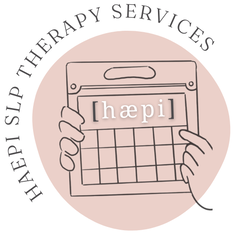|
Let me preface this post by saying that *high-tech AAC is worth any and all technical difficulties that may come with it*… but as with all kinds of technology, stuff happens and we should always be prepared. So, here are my top tips for getting started with AAC: - Invest in a good screen protector and case. The AAC device is going to go along with the child in most (if not all) of their environments, so it's a good idea to plan for durability and provide additional support based on however the child is going to carry it. - Enable guided access. This 'locks' the child into the AAC app and teaches them that the device is meant to *only be used for communication.* Games and videos can still be accessible to them, just on a separate device! - Back up your vocabulary! All AAC programs will have methods for backing up your data (e.g., Dropbox, email, airdrop) and it's important to do that regularly! *When* (not if!) you run into tech troubles, you don’t want to lose all customizations you've made within the program! by Halle Demchuk, SLPPaediatric SLP | GLP-Trained Clinician | Owner of HAEPI SLP Especially useful for GLPs and late talkers, declarative language offers a gentler approach to communication by *inviting children to act* as opposed to pressuring them to respond in a particular or expected way. Whereas questions and directives are a means to an end, declarative statements actually increase independence by giving the child the space they need to notice what’s happening in their environment, process what has been said to them, and then respond with their own thoughts and ideas. In other words, declarative language helps to create space for connection and is a fantastic tool for child-led play. Here are some examples of declarative statements from Meaningful Speech:
by Halle Demchuk, SLPPaediatric SLP | GLP-Trained Clinician | Owner of HAEPI SLP PSA: we can customize and modify language systems (such as high-tech AAC, as shown above) to support bilingual language learners. This child has an interest in learning animal names in Ojibway, and we can use AAC to support his expressive vocabulary in this language. While there are currently no AAC systems that have Indigenous languages programmed into them, programs like LAMP (Language Acquisition by Motor Planning) are easily customizable and allow for this addition. This child's motor plan is still kept consistent while navigating between the two languages. It’s an honour to support this child’s journey with his language! by Halle Demchuk, SLPPaediatric SLP | GLP-Trained Clinician | Owner of HAEPI SLP
This will likely be a *controversial* post, but I am not trained in (and will not be trained in) using PECS (the Picture Exchange Communication System) for my AAC users for a number of reasons.
PECS focuses heavily (!!!) on requesting, and this can often result in communication only being used as a source of extrinsic motivation (i.e., to get something). It doesn’t take into account all the other reasons to communicate (such as greet, negate, argue, comment, suggest, direct, etc) in order to build intrinsic motivation to communicate. Communication and connecting should be the reward! Teaching PECS often involves hand-over-hand prompting of the child, violating their bodily autonomy. This is not a necessary part of learning picture communication. Modelling for the student on their device with no expectation for the child to copy is an evidence-based way to teach picture/symbol communication, which allows for the child to regain this autonomy and express what they WANT to express. Furthermore, PECS doesn't allow a motor plan to develop as the symbols are always moving, which is an important part of communicating with a symbol-based system. Since PECS focuses on single words to start, it also is not the most appropriate for our gestalt language processors (and up to 85% of Autistic children are GLP!). We don't want our AAC to further contribute to our children being 'stuck' in their single-word or multi-word scripts. And lastly, PECS is not a robust language system that can grow with the child. Our children can learn much more competently if their communication systems are robust from the start, and not being 'upgraded' every few years. We need to presume competence right from the start. NOTE: This is in reference to the Picture Exchange Communication System and not all picture-based communication, such as low tech AAC and core boards. ​While PECS may have a been a gold standard in the past, and many well-meaning therapists have endorsed its use, it's important to listen to our Autistic community who have talked about the negative aspects of the system. Once we know better, we can do better. by Halle Demchuk, SLPPaediatric SLP | GLP-Trained Clinician | Owner of HAEPI SLP
As shown by this real-life example, it's important to do the detective work to figure out the meaning behind delayed echolalia and the gestalts that are picked up by your child naturally, because gestalts communicate!
In this example, the child is communicating with a gestalt that had been stored in his episodic memory. During the balloon exercise, he might *feel* the same excited way he felt watching the scene in the show, and is expressing that feeling with his gestalt. Now that we recognize and understand why he is using this gestalt, where it came from, and what it means to him, we can validate his gestalt. We might also model something else that is a little easier to understand and mitigate, such as "it's a surprise"! by Halle Demchuk, SLPPaediatric SLP | GLP-Trained Clinician | Owner of HAEPI SLP |
The HAEPI BlogCheck here for HAEPI updates, helpful SLP information, free resources, articles, and more!
Archives
June 2024
Categories
All
|
Empowering Happy Communicators |
get in touch |
Quick Links |
© HAEPI SLP THERAPY SERVICES.
HAEPI SLP Therapy Services is proudly neurodiverse, Indigenous-owned, and woman-operated.






